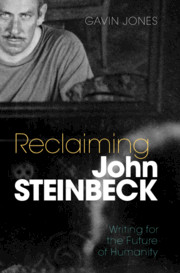Book contents
- Reclaiming John Steinbeck
- Reclaiming John Steinbeck
- Copyright page
- Dedication
- Contents
- Figures
- Acknowledgments
- Introduction Loving and Hating Steinbeck
- Chapter 1 Short Stories in School and Lab: “Tularecito” and “The Snake”
- Chapter 2 Drought, Climate, and Race in the West: To a God Unknown
- Chapter 3 Race and Revision: “The Vigilante” and “Johnny Bear”
- Chapter 4 Becoming Animal: Theories of Mind in The Red Pony
- Chapter 5 What Is It Like to Be a Plant? “The Chrysanthemums” and “The White Quail”
- Chapter 6 On Not Being a Modernist: Disability and Performance in Of Mice and Men
- Chapter 7 Emergence and Failure: The Middleness of The Grapes of Wrath
- Chapter 8 Borderlands: Extinction and the New World Outlook in Sea of Cortez
- Chapter 9 Mexican Revolutions: The Forgotten Village, The Pearl, and the Global South
- Epilogue The Aftertaste of Cannery Row
- Notes
- Index
Chapter 4 - Becoming Animal: Theories of Mind in The Red Pony
Published online by Cambridge University Press: 02 July 2021
- Reclaiming John Steinbeck
- Reclaiming John Steinbeck
- Copyright page
- Dedication
- Contents
- Figures
- Acknowledgments
- Introduction Loving and Hating Steinbeck
- Chapter 1 Short Stories in School and Lab: “Tularecito” and “The Snake”
- Chapter 2 Drought, Climate, and Race in the West: To a God Unknown
- Chapter 3 Race and Revision: “The Vigilante” and “Johnny Bear”
- Chapter 4 Becoming Animal: Theories of Mind in The Red Pony
- Chapter 5 What Is It Like to Be a Plant? “The Chrysanthemums” and “The White Quail”
- Chapter 6 On Not Being a Modernist: Disability and Performance in Of Mice and Men
- Chapter 7 Emergence and Failure: The Middleness of The Grapes of Wrath
- Chapter 8 Borderlands: Extinction and the New World Outlook in Sea of Cortez
- Chapter 9 Mexican Revolutions: The Forgotten Village, The Pearl, and the Global South
- Epilogue The Aftertaste of Cannery Row
- Notes
- Index
Summary
Edmund Wilson’s famous critique that Steinbeck’s stories are “almost entirely about plants and animals” is tackled in this chapter, which argues that Steinbeck’s attention to the inner life of nonhuman animals represents a radical rethinking of humanity’s claims to privilege as a species. Focusing on Steinbeck’s representation of human and animal characters in The Red Pony--in particular his ascription of interiority to animals and his reduction of humans to pure behavior--I argue that Steinbeck’s work approaches a post-human ethical pluralism that defines humans according to their fallibility and cognitive deficits. However, Steinbeck’s exploration of the human-animal connection becomes more complex when we examine the relationship between the separate stories of The Red Pony, which interweave tales about animals with stories about the Western frontier. Once again, Steinbeck’s biological focus on humans as a species becomes caught up in problems of race that leave unchallenged a mythic ideology of the West, one that disguises the racial slaughter undergirding the animalistic emergence of white identity.
Keywords
- Type
- Chapter
- Information
- Reclaiming John SteinbeckWriting for the Future of Humanity, pp. 73 - 88Publisher: Cambridge University PressPrint publication year: 2021

